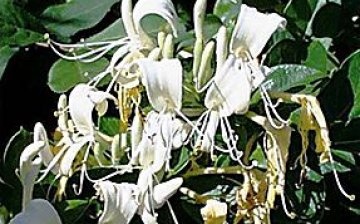Decorative liana - Japanese honeysuckle
Lonicera japonica - Japanese honeysuckle - refers to an evergreen or semi-evergreen plant that is suitable for most types of vertical landscaping. This vine is used for carpet flower beds and borders, as a room culture in stands, columns, trellises, etc.
It is known that Japanese honeysuckle has flowers and young shoots covered with fluff.
Leaves are ovoid, 3-8 cm long and 1.5-4.5 cm wide, are attached with a short petiole. At a young age, the leaves of such a plant are pubescent on both sides. And in the process of aging, the fluff gradually disappears. However, small cilia still remain at the edges.
The flowers are paired, white with a purple tint, quite fragrant, located on peduncles. The latter are often slightly longer than the petiole. The ovaries are usually 3-celled. The pubescent corolla from the outside in length reaches from 3 to 5 cm. The column and stamens slightly protrude beyond the edge of the limb. The berries are predominantly black and include elliptical seeds.
Japanese honeysuckle is most widespread in China, Japan and Korea.
The flowers of this plant are widely used in the perfumery industry.
It is important to know that such a vine can serve as a host plant for the causative agent of pierce disease. This ailment causes burns and browning of the leaves of grapes, and in the future - wrinkling and separation of the fruits.
In a wild state in the Caucasus, honeysuckle is considered as a weed used on tea plantations, as well as other agricultural areas. It develops quite quickly, tolerates moisture well. In the second year after planting, it blooms. It was introduced at the end of the 19th century.



